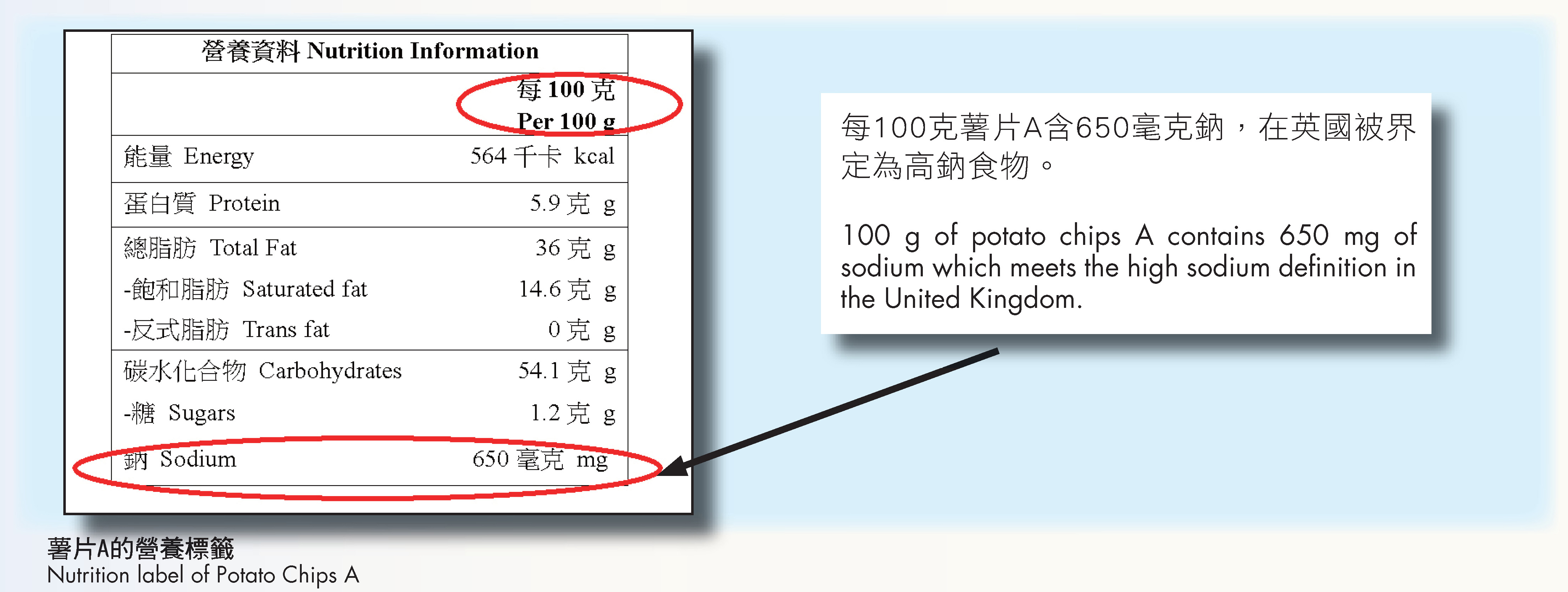
Food Safety Focus (76th Issue, November 2012) – Food Safety Platform
Cut down Sodium Intake from Crispy Chips
Reported by Ms. Michelle CHAN, Scientific Officer,
Risk Communication Section,
Centre for Food Safety
In the last issue, we introduced a user-friendly tool, “three-steps to use nutrition labels” (three-steps), and demonstrated how it helps get less fat from instant noodles. In this issue, we will show you how to cut down sodium intake from crispy chips with the three-steps.
Take a Look at Sodium
Sodium is essential to maintain body fluid balance, for nerve transmission and muscle contraction. Talking about sodium, many people will immediately think of table salt. In fact, table salt is only one of the many dietary sources of sodium. People may also ingest sodium naturally present in foods and drinking water as well as those from sodium-containing food additives and condiments like monosodium glutamate (MSG) and soy sauce in prepackaged foods.
Prolonged excessive intake of sodium increases the risk of developing high blood pressure which is a risk factor for coronary heart diseases and stroke. The World Health Organization and the Food and Agriculture Organization of the United Nations recommend limiting daily sodium intake to 2000 mg (approximately equivalent to 5 g or one level teaspoon of table salt). In the United Kingdom, foods with high sodium refer to those with over 600 mg of sodium per 100 g of food.
Crispy Chips and Sodium
Potato chips, prawn crackers, tortilla chips are some of the crispy chips available in the market. In manufacturing these products, the raw materials or their mixes are first sliced or extruded into the desired shapes which are then deep fried or baked. After cooling, salt and flavoured powder containing sodium are added to give a variety of tastes.
Sodium also presents in some commonly used food additives such as flavour enhancer (e.g. MSG) and raising agent (e.g. sodium carbonate).
Cut down Sodium Intake from Crispy Chips with Three-steps
Firstly, read the nutrition label. Check the sodium level. Among the food samples collected in the Centre for Food Safety (CFS) Study on Sodium Content in Local Foods in 2012, nutrition labels of 24 crispy chips samples were examined. The data revealed greatly varied sodium contents of food, ranging from 172 to 1800 mg per 100 g. Consumers should read nutrition labels to identify the lower sodium options.
Secondly, know how much I eat. Make reference of the consumption amount to the reference amount on the nutrition labels for calculating nutrient intake. Nutrition label of crispy chips is usually expressed as “per 100 g”. Your sodium intake varies proportionately with your consumption amount of food. To estimate your consumption amount, check out the net weight of food and compare your consumption amount to 100 g.
For instance, the net weight of a pack of potato chips A is 60g. If you consume the whole pack in one go, your consumption amount will account for 60 g/100g = 3/5 of the 100 g of food. Thus, you will get 3/5 of sodium as shown on the nutrition label. Referring to the nutrition label below, 100 g of potato chips A contain 650 mg of sodium, 60 g of the food provides 650 mg x 3/5 = 390 mg of sodium.

Thirdly, make better choices. Compare your nutrient intake to your daily intake upper limit. Consumption of the whole pack of potato chips A accounts for about 20% of your daily limit. To reduce sodium intake, you can:
- consume potato chips A less frequently and in less amount;
- decrease consumption of high sodium food such as preserved and canned food in that day and/or by using less salt or sodium containing seasonings;
- compare nutrition labels to choose crispy chips with less sodium.
More Healthy Tips
Food manufacturers can make reference to the CFS Trade Guidelines for Reducing Sodium in Foods to formulate food with lower sodium content. Consumers should also pay attention to total fat and saturated fat contents of the crispy chips especially those deep-fried ones.
In the next issue, we will show you how to reduce sugars intake from breakfast cereals with the three-steps.


